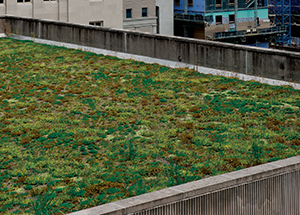Hidden Treasures: Sleek-and-Green Living Roofs
With its exposed concrete columns and window-covered facade, Benedum Hall is a striking fixture of Pitt’s campus. And while the building’s modern and sleek design is visually compelling, it’s sustainable, too. Growing atop Benedum Hall’s roofs are secret gardens known as living green roofs, which reduce water runoff, aid in heat absorption, and are emblematic of Pitt’s commitment to sustainable practices.
Above the Benedum Hall Plaza is an intensive green-roof system, ideal for growing and housing lawns, perennial plants, and trees. This greenery has birthed a social gathering space for faculty, staff, and students. Covering the roof above Benedum’s auditorium—a separate green space—is an extensive green-roof system made up of green and brown vegetation that soaks up sun and rain.
is an intensive green-roof system, ideal for growing and housing lawns, perennial plants, and trees. This greenery has birthed a social gathering space for faculty, staff, and students. Covering the roof above Benedum’s auditorium—a separate green space—is an extensive green-roof system made up of green and brown vegetation that soaks up sun and rain.
Living green roofs act as buffers between heavy rainfall and storm-water management systems—a significant issue in Pittsburgh. The city’s aging sewer systems struggle to manage large flushes of water. Green roofs, such as those seen on top of Benedum Hall, slow the water and, in some cases, retain rainfall completely. In addition, the green spaces help absorb sunlight, reducing the surrounding “urban heat island,” or the higher temperatures born of the sun’s heat reflecting off of the city’s concrete and asphalt. The roof houses a reflective thermoplastic polyolefin, a type of roofing membrane that also minimizes heat absorption.
This attractive and sustainable space has garnered attention across campus and, coupled with the recent renovations completed within Benedum Hall, the University has earned a LEED Gold certification. While these vegetation roofs may not be quite as utopic as history’s original vegetative roofs (think: Hanging Gardens of Babylon in 4th century BC), they certainly do their fair share of building a sustainable future at Pitt.
—By B. Rose Huber
Other Stories From This Issue
On the Freedom Road

Follow a group of Pitt students on the Returning to the Roots of Civil Rights bus tour, a nine-day, 2,300-mile journey crisscrossing five states.
Day 1: The Awakening
Day 2: Deep Impressions
Day 3: Music, Montgomery, and More
Day 4: Looking Back, Looking Forward
Day 5: Learning to Remember
Day 6: The Mountaintop
Day 7: Slavery and Beyond
Day 8: Lessons to Bring Home
Day 9: Final Lessons

